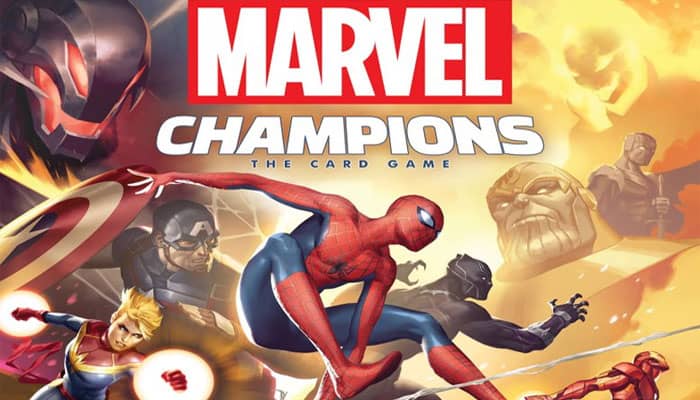
[Marvel Champions: The Card Game is a cooperative card game for one to four players. Each player takes the role of one Marvel hero, playing the game as that character and their alter-ego.
In the game, the players work together to defeat a villain (controlled by the game) who is trying to complete an evil scheme.

Components
- 199 Player cards
- 137 Encounter cards
- 7 Reference cards
- 30 Status cards
- 62 Damage tokens
- 16 All-purpose counters
- 33 Threat tokens
- 5 Acceleration tokens
- 1 First player token
- Rulebook
Setup
To set up the first game, perform the following steps in order.
For the first game, we recommend playing with only one or two players and using the heroes Spider-Man and Captain Marvel against the villain Rhino. Instructions for setting up this specific scenario are provided with each step.
The Spider-Man, Captain Marvel, and Rhino decks have been pre-sorted in the core set for convenience. Only the cards in these three decks are used in the tutorial game.
-
Select Heroes. Each player selects one identity card and places its alter-ego side face up in front of them.

Remove the spider-man/peter parker identity card from his deck and (if a second player is playing) remove the Captain Marvel/Carol Danvers identity card from her deck. set each card to its alter-ego side.
-
Set Hit Points. Each player sets their hit point dial equal to the starting hit points of their character, found at the bottom of their identity card.

Set Spider-Man's nit point dial to 10. Set Captain Marvel's nit point DIAL TO 12.
-
Select First Player. As a group, the players select a first player and place the first player token in front of that player.
-
Set Aside Obligations. For each hero being played, set aside their obligation card. These cards are used later in setup.

Remove the eviction notice card from the Spider-Man deck and set it aside. Remove the family emergency card from the captain marvel deck and set it aside.
-
Set Aside Nemesis Sets. For each hero being played, set aside their nemesis and the encounter cards for that nemesis. (The nemesis cards do not start the game in play, but may be brought into play by other card abilities during the game).
Remove all of the spider-man nemesis cards from the spider-man deck and set them aside. Remove all of the captain marvel nemesis cards from the captain marvel deck and set them aside.

-
Shuffle Player Decks. Each player shuffles their player deck and places it near their identity card.
The Spider-Man deck consists of the remaining Spider-Man cards, as well as the justice (yellow) and basic (gray) cards from that starter pack.
The Captain Marvel deck consists of the remaining captain marvel cards, as well as the aggression (red) and basic (gray) cards from that starter pack.

-
Collect Tokens and Status Cards. Create a pool of damage tokens, threat tokens, and all-purpose counters within reach of each player. Place stacks of stunned, confused, and tough status cards near this pool.

-
Select Villain. Select a villain and put their villain deck and main scheme deck into play near the center of the play area.

Use Rhino as the Villain, with Rhino (I) and rhino (II) as the villain deck. Stack Rhino's Villain deck in sequential order, so that Rhino (I) is on the top and Rhino (II) is on the bottom.
The scheme deck for this scenario is one card, the break-in! Put this card into play on its ia side.
-
Set the Villain's Hit Points. Set the villain's hit point dial to the number near the bottom of the villain card multiplied by the number of players, as shown by the "per player" symbol (
 ) on the card.
) on the card. -
Resolve Scheme Setup. Resolve any "Setup" instructions on the main scheme card.
Read the intro text on side 1Aa of the break-in! and turn it over to advance to stage 1B.

-
Create and Shuffle Encounter Deck. Shuffle the obligation cards that were set aside during step four into the villain's encounter deck.
Rhino encounter deck: all of the Rhino cards, all of the standard encounter cards, and all of the bomb scare cards.

If Spider-Man is being used, shuffle the eviction notice obligation into the encounter deck. If Captain Marvel is being used, shuffle the family emergency obligation into the encounter deck. The Nemesis cards remain set aside until called for by an encounter card.

-
Draw Cards. Each player draws a number of cards from their player deck equal to their hand size, which is listed near the bottom left corner of their identity card.
Peter Parker draws 6 cards. Carol Danvers draws 6 cards.

-
Resolve Mulligans. Each player may discard any number of cards from their hand, then draw up to their starting hand size. (Do not shuffle these discarded cards back into their decks at this time).

A mulligan is an opportunity for players to improve their starting hand. If a player likes the cards in their hand, they should keep those cards. If there are any cards a player does not like in their hand, mulligan those specific cards.
-
Resolve Character Setup Abilities. Resolve any "Setup" instructions listed on identity cards in play.
There are no character setup instructions for Spider-man or Captain Marvel.
The game is now ready to begin...

Key Concepts
This section introduces a number of foundational concepts important to learning and playing the game.
The Golden Rule
If the text of a card directly contradicts the rules of this document, the text of the card takes precedence.
Per Player ( )
)
The  symbol next to a value multiplies that value by the number of players who started the scenario.
symbol next to a value multiplies that value by the number of players who started the scenario.
Winning and Losing
The villain is represented by multiple villain cards, and each card has a stage number in its upper-right corner.

The players defeat a villain stage by reducing its hit points to zero, which advances the game to the next villain stage. If the players defeat the final villain stage, they win the game.
The villain wins the game if they complete their scheme or if all of the players are eliminated. The scheme is completed if the villain accumulates the amount of threat specified by the final card of their scheme deck. A player is eliminated if their hit points are reduced to zero.

To complete this scheme, the villain must accumulate 7 threat per player on it. as it is the final (and only) card in the Rhino scheme deck, Rhino wins the game if it is completed.
Ready and Exhausted
Cards enter play in a ready position (upright). In order to use some card powers and abilities, the card must exhaust, which is indicated by rotating the card sideways A card in the exhausted position is not able to exhaust again until it is ready (upright).

"In Player Order"
The phrase "in player order" is sometimes used to dictate the order in which players resolve a game step. If players are instructed to do something "in player order", the first player does so first, followed by each other player, one player at a time, in clockwise order around the table.
Game Play
Marvel Champions: The Card Game is played over a series of rounds. Each round consists of a player phase and a villain phase.
During the player phase, the players take their turns in player order. During their turn, a player can play cards from their hand, attack enemies, thwart the villain's schemes, and use the ally, support, and upgrade cards they have in play.
After all players have taken a turn, the player phase ends and play proceeds to the villain phase.
At the start of the villain phase, threat is placed on the main scheme. Then, the villain activates once per player and either attacks the player or further advances their scheme.
Next, the game reveals cards from the encounter deck, which adds minions, treacheries, side schemes, and attachments that develop the villain's forces and beleaguer the heroes.
After the villain phase is complete, the first player token passes to the next clockwise player, and the next round begins. The game advances in this manner until either the players win as a team or the villain wins.
I. Player Phase
During the player phase, each player takes their turn in player order until each player has taken a turn.
After the players have each taken a turn, the players draw up to their hand sizes and ready their cards. Then, the game advances to the villain phase.
Player Turn
During their turn, a player may perform any of the following options, in any order. Each option (aside from changing form) may be performed as many times as the player desires, so long as they have the necessary cards and resources to pay the costs.
Each of the options listed below is described in greater detail on the following pages.
Change form from hero to alter-ego, or from alter- ego to hero. This option may only be performed once each turn.
Play an ally, upgrade, or support card from their hand.
Use their alter-ego's basic recovery (if in alter-ego form) or their hero's basic attack or basic thwart power (if in hero form).
Use an ally card they control to attack an enemy or thwart a scheme.
Trigger an "Action" card ability on a card in play they control, on an encounter card in play, or by playing an event card with such a timing trigger from their hand. If the action ability is preceded by "Hero" or "Alter-Ego", the player must be in the specified form in order to trigger the ability.
Ask another player to trigger an "Action" ability on a card in play they control or on an event card they might have in hand. The other player then decides whether or not to trigger the ability. (Another player may offer to use an action during the active player's turn, as well).
Changing Form
To change from hero to alter-ego, or from alter-ego to hero, the player announces their intent and flips their identity card to its other side. Each player may change form once each round, only during their own turn.
When a player changes form, their character remains in the same state (ready or exhausted). Any upgrades, attachments, tokens, damage, and status cards on the character remain.
Playing a Card
To play a card from their hand, a player performs the following steps:
- Place the card they want to play on the table.
- Pay the card's cost. (See the "Resource Costs" sidebar).
- If the card is an ally, upgrade, or support, it enters play ready in that player's play area. If the card is an event, resolve its effects and place it in its owner's discard pile.

Ally Limit
Each player may have up to three allies in play under their control at any given time.
A player who controls three allies may play a different ally, immediately discarding one of their previous allies.
Resource Costs
Resource costs are paid by generating resources . Resources can be generated in two ways. The first is to discard a card from hand, which generates a number of resources equal to the number of resource icons on the card.
The second is to use a card with a "Resource " ability, which generates the resource specified by the ability. Any resources that are generated beyond the cost are lost after paying the cost.
The resource type a card provides is in its bottom- left corner . The icons shown indicate the number and type of resources generated by discarding the card. The resource types in the game are:

A wild resource may be used as any other resource type (mental, physical, or energy).
Generally, when playing cards from hand, any type ( or combination of types) of resources may be used to pay the card's cost. However , many abilities and encounter card effects require a specific type (or combination of types) of resources to be paid.

Using a Basic Power
Basic powers can be found on the player's identity card. The hero side has the character's basic attack power, basic thwart power, and basic defense power. The alter-ego side has the character's basic recovery power. To use a basic power, the character must be in the form that has that power.
To use a basic power, a player performs the following steps:
- Declare the power they want to use.
- Pay the power's cost. This is done by exhausting the hero or alter-ego.
- Resolve the effect of the power.
Basic Recovery: The player exhausts their alter-ego and heals a number of hit points equal to their REC value. Healing increases the player's hit point dial by the indicated amount. A player cannot heal above their maximum hit points.

Basic Thwart: The player exhausts their hero and removes an amount of threat (described later) equal to their THW value from one scheme of their choice. Any scheme can be thwarted unless a card ability (such as the crisis symbol) prevents it.
Basic Attack: The player exhausts their hero and deals an amount of damage (see "Dealing Damage" sidebar) equal to their ATK value to one eligible enemy. Any enemy-villain or minion-in play is eligible unless a card ability (such as the guard keyword) prevents it.
Basic Defense: This power may only be used when any hero is being attacked by an enemy. When this occurs, a player may exhaust their hero to prevent an amount of damage equal to their DEF value. A hero may defend themselves or any other hero. The hero that is defending takes damage (tracked on their hit point dial) from the attack that exceeds their DEF value.

Dealing Damage
Many card abilities and attacks deal damage. Damage dealt to a minion or ally is immediately placed on the card using damage tokens. Each damage on a card reduces the card's hit points by one. If a card has zero (or fewer) hit points remaining, the card is defeated and placed in its owner's discard pile.
Damage dealt to a player or villain immediately decreases the character's hit point dial. If a villain's dial reaches zero, the current stage of the villain is defeated, and the villain advances to the next stage.
When the villain advances , set the villain 's hit point dial to the amount indicated by the newly revealed stage. If the final stage of the villain is defeated, the players win the game. If a player's hit point dial reaches zero, that player is eliminated from the game.
Using an Ally
During their turn, a player may use any number of allies they control to attack an enemy or to thwart a scheme.
To use an ally, a player performs the following steps:
Exhaust the ally. (If the ally was already exhausted, it cannot be used in this way).
Declare whether they are using the ally to attack an enemy or thwart a scheme.
Declare which enemy they are attacking or which scheme they are thwarting. Any enemy can be attacked unless a card ability says otherwise. Any scheme can be thwarted unless a card ability says otherwise.
Resolve the attack by dealing the specified amount of damage to the enemy. Resolve the thwart by removing the specified amount of threat from the scheme.
Deal consequential damage. If the ally that attacked has any damage icons under their ATK, deal the specified amount of damage to the ally. If they thwarted and have any damage icons under their THW, do the same.
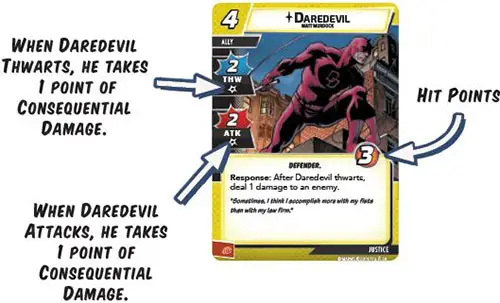
Triggering an Action Ability
Action abilities are indicated by the word "Action" in bold. A player can trigger abilities from cards they control in play, from event cards they play from their hand, or from encounter cards that have such an ability. To trigger an action ability, a player performs the following steps:
-
Declare which action ability they want to trigger.
-
Pay the ability's cost, which precedes its effect, and is separated from the effect by an arrow icon.
The generated resources must match the resources shown in the ability's cost. Not all abilities have a cost, and some abilities have additional costs, such as "exhaust this card", which must also be paid.
-
Resolve the effect of the action ability.
A given action ability may be triggered any number of times per turn, so long as its costs can be paid and its effect can change the game.
For other ability types, see the sidebar to the right.
Hero and Alter-ego Abilities
If an ability is preceded by the word "Hero" or "Alter- Ego", or if an ability's text references a specific form, the player must be in the specified form in order to use or interact with the ability.
If an ability does not specify a form, that ability may be used while the player is in either form.
Action Abilities on Encounter Cards
Some encounter cards have action abilities that players may use while the card is in play. During their turn, a player may pay the specified cost on an encounter card with such an ability to resolve it. There is no limit to the number of times this may be done during a turn, so long as that player pays each cost.

Other Triggered Abilities
In addition to action abilities, which a player can trigger during their turn (or by request during another player's turn), there are a few other types of triggered abilities in the game: Interrupts, Responses, and Resource abilities.
Using these types of triggered abilities is optional, unless the bold ability trigger is preceded by the word " Forced ". Each copy of a triggered ability may be used once each time the situation described by its text occurs.
"Resource" abilities may be used anytime the player who controls the ability is generating resources to pay a cost. Unless otherwise noted, the player who controls the resource card must be the player who is paying the cost.
"Interrupt" abilities may be used any time their specified condition (as described by the text of the ability) would occur, immediately before that condition occurs. These abilities prevent or preempt an occurrence, sometimes stopping it outright, and sometimes changing the occurrence to something else.
"Response" abilities may be used any time their specified condition (as described by the text of the ability) is met, immediately after that specified condition resolves or occurs.
End of a Player's Turn
When a player has completed everything they can or wish to do on their turn, that player announces that their turn is complete. The next player (in clockwise order) begins their turn.
After all players have completed a turn, proceed to the "End of Player Phase" sequence below.
End of Player Phase
To end the player phase, perform the following steps:
-
In player order, each player may discard any number of cards from their hand and must discard down to their hand size (located at the bottom of their identity card) if they have more cards than their hand size.
-
Each player simultaneously draws cards from their deck until the number of cards in their hand equals their hand size.
-
Each player simultaneously readies all of their cards.
After completing the above steps, the player phase is complete. Proceed to the villain phase.
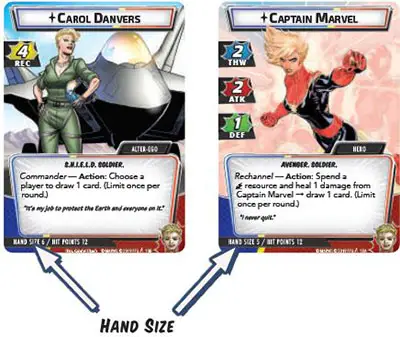
II. Villain Phase
During the villain phase, the enemies strike back! The villain activates, minions attack, and new encounter cards come into play, challenging the heroes with additional enemies and threats.
To play the villain phase, the players resolve the following steps, which are explained in detail on the following pages:
- Place threat on the main scheme.
- The villain activates once per player, along with any eligible minions.
- Deal one encounter card to each player.
- Reveal encounter cards.
- Pass the first player token and end the round
The Scheme Deck
The scheme deck represents the villain's primary objective. If a villain completes the final stage of the scheme deck, the villain wins the game. For some villains, the main scheme deck is just one stage.
Some main schemes start with threat on them. The amount of threat placed on the scheme when it enters play (or begins the game in play) is indicated at the bottom of the card.
When a card or game rule instructs an enemy or villain to scheme, a number of threat equal to the SCH value of that enemy is placed on the main scheme.
Each main scheme has a target threat value (top-left corner) that indicates the amount of threat needed on it before the scheme deck advances. Threat is checked continuously; anytime the amount of threat on a main scheme card is equal to or greater than the card's target threat, the scheme deck advances to the next stage.
(The threat from the previous stage is removed and returned to the token pool. If the final stage of the scheme deck advances, the players immediately lose the game.

Step One - Place Threat
Place the amount of threat indicated in the main scheme's acceleration field onto that scheme. If any side schemes with an acceleration icon are in play, they modify the amount of threat placed at this time.
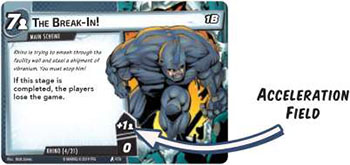
Step Two - Villain and Minion Activations
The villain activates once against each player, in player order. After the villain activates against a player, each minion engaged with that player also activates.
These activations resolve differently based on the player's character form. If the player is in their alter-ego form, the villain or minion schemes. If the player is in their hero form, the villain or minion attacks.
After the villain completes its activation for a player, it activates for the next player (in player order), continuing until it has activated for all players.
Strategy Tip
Your character's form (hero or alter-ego) greatly influences the villain's behavior each round. If you need to prevent the villain from scheming, make sure you are in hero form to confront them.
If you are so worn down that you think an attack could be dangerous, it might be better to stay in alter-ego form to recover hit points and build up your forces. Just remember, in alter-ego form you won't be around to stop the villain from advancing their evil plans!
Finding the right balance between your hero and your alter-ego is one of the key skills to master as a Marvel champion.
Alter-ego Form: Enemies Scheme
If the player is in alter-ego form, the villain (and each minion engaged with that player) schemes. To resolve this activation, perform the following steps:
-
Give the villain a facedown card from the encounter deck. This is the villain's boost card for this activation.
-
Flip the boost card face up. For each boost icon at the bottom-right of the card, the villain gets +1 SCH for this activation.

If there is a star icon in the boost field, the star itself does not provide +1 SCH. This icon indicates that the card's text box has an associated ability, also marked with a star, that resolves after the card is flipped face-up.
Discard the boost card at the end of this step.
-
Place threat on the main scheme equal to the villain's modified SCH value. (Threat is placed on a scheme using threat tokens).
-
If any minions are engaged with the player resolving this activation, those minions now scheme, one minion at a time. For each minion that schemes, place threat on the main scheme equal to that minion's SCH value. (No boost cards are dealt to scheming minions).

Hero Form: Enemies Attack
If the player is in hero form, the villain (and each minion engaged with that player) attacks. To resolve this activation, perform the following steps:
-
Give the villain a facedown card from the encounter deck. This is the villain's boost card for this activation.
-
The attacked player chooses if they want to defend against the attack. To defend, the player must either exhaust their hero or exhaust an ally they control.
If the attacked player does not defend, any other player may defend against the attack by exhausting their hero or an ally they control.
-
Turn the boost card face up. For each boost icon at the bottom-right of the card, the villain gets +1 ATK for this activation.
If there is a star icon in the boost field, the star itself does not provide +1 ATK. This icon indicates that the card's text box has an associated ability, also marked with a star, that resolves after the card is flipped face-up.
Discard the boost card at the end of this step.
-
Deal damage equal to the villain's modified ATK value, as follows:
If a hero is defending against the attack, the amount of damage dealt is reduced by that hero's DEF value, and the remaining damage from the attack is dealt to that hero.
If an ally is defending against the attack, all damage from the attack is dealt to that ally.
If no character is defending against the attack, all damage from the attack is dealt to the hero that is resolving this activation.
-
If any minions are engaged with the player resolving this activation, those minions attack that player, one minion at a time. Resolve each minion's attack as in steps two and four, but use only the minion's ATK value to determine how much damage is dealt. (No boost cards are dealt to attacking minions).
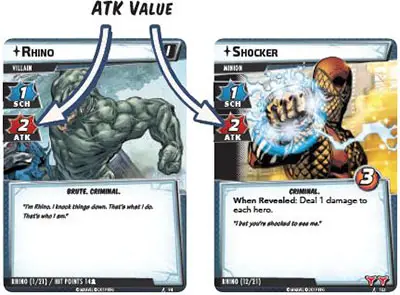
Step Three - Deal Encounter Cards
Deal one card from the encounter deck facedown to each player in player order.
Step Four - Reveal encounter cards
All of the encounter cards dealt in the previous step are revealed and resolved, one at a time, in player order.
When an encounter card is revealed, it is resolved based on its card type, as follows:
Minion - When a minion is revealed, it enters play engaged with the player who revealed the card. Place the minion near that player to show that it is engaged.
Treachery - When a treachery is revealed, resolve its effect and then place it in the encounter discard pile.
Attachment - When an attachment is revealed, it enters play attached to the villain.
Side Scheme - When a side scheme is revealed from the encounter deck, it enters play near the main scheme. Side schemes enter play with an amount of threat already on them.
Threat may be removed from a side scheme when heroes or allies use their basic thwart power, or via card abilities. If a side scheme has zero threat on it, it is discarded to the encounter discard pile.
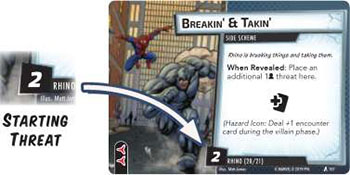
Side Scheme Icons
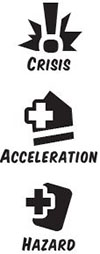
If a side scheme has the crisis icon, it must be defeated before threat can be removed from the main scheme.
For each side scheme in play with the acceleration icon, one additional threat is placed on the main scheme during step one of the villain phase.
For each side scheme in play with the hazard icon, an additional encounter card is dealt during step three of the villain phase. Additional cards are dealt in player order (first additional card to the first player, the second to the second player, etc)..
When Revealed Abilities
If a revealed encounter card has any "When Revealed" abilities, those abilities resolve immediately after the card enters play. (In the case of treachery cards, which do not enter play, the "When Revealed" ability resolves and the card is then placed in the encounter discard pile).
When Defeated Abilities
Some minions and side schemes have "When Defeated" abilities. These abilities trigger when the players defeat the minion, villain stage, or scheme card that has the ability.
Alter-ego Form and Hero Form
Often, the way an encounter card resolves depends on whether the player revealing the card is in hero or alter- ego form. If a revealed encounter card has an ability that specifies "Alter-Ego" or "Hero", resolve the ability only if the player revealing the card is in the specified form.
Nemesis Side Schemes
If a card instructs a player to put a nemesis side scheme into play, the nemesis side scheme associated with the player that drew the card is placed in the play area, and their nemesis minion is put into play engaged with that player.
The other encounter cards associated with that nemesis are placed in the encounter discard pile.
Each hero's nemesis, side scheme, and associated cards are as follows:
Spider-Man: Vulture, Highway Robbery, The Vulture's Plans, Sweeping Swoop (x2)
Captain Marvel: Yon-Rogg, The Psyche-Magnitron, Kree Manipulator (x2), Yon-Rogg's Treason
Iron Man: Whiplash, Imminent Overload, Electric Whip Attack (x2), Electromagnetic Backlash
She-Hulk: Titania, Personal Challenge, Genetically Enhanced, Titania's Fury (x2)
Black Panther: Killmonger, Usurp the Throne, Heart-Shaped Herb, Ritual Combat (x2)
Obligations
During setup, each player shuffles their character's obligation card into the encounter deck.
If an obligation is revealed from the encounter deck, immediately give it to the player controlling the character indicated by the obligation. That player follows the instructions on the obligation to resolve it.
End of the Round
Pass the first player token clockwise to the next player. End the round, and begin the next player phase.
The Cards and Decks
Read here for an overview of the many different types of cards in the core set and card decks.
End of the Game
After the Player and Villain phase is completed, the next round begins until either the players win as a team or the Villain wins.
What's Next?
You now know the basics of playing MARVEL Champions: The Card Game.
After playing the introductory game, try playing the Rhino scenario with different preconstructed starter decks that feature other heroes.
Continue Reading


